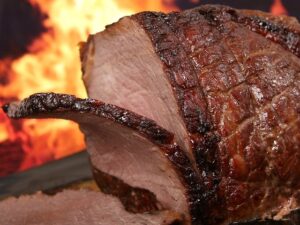Introduction
When it comes to determining the protein content in a slice of ham, it’s important to consider the specific type of ham and its preparation method. Ham is a popular meat product that is often consumed as part of sandwiches or as a main dish. It is known for its rich flavor and versatility in various recipes. In this article, we will explore the protein content in a slice of ham and provide insights into its nutritional value.
Protein Content in Ham
Ham is a good source of protein, which is an essential macronutrient that plays a crucial role in building and repairing tissues, supporting immune function, and maintaining overall health. The protein content in a slice of ham can vary depending on factors such as the cut of meat, fat content, and cooking method.
On average, a slice of ham weighing around 28 grams (1 ounce) contains approximately 9 grams of protein. This protein content can slightly vary depending on the specific type of ham. For example, leaner cuts of ham, such as boiled or roasted ham, tend to have a higher protein content compared to fattier cuts like bacon.
Nutritional Profile of Ham
In addition to protein, ham offers other essential nutrients that contribute to a well-rounded diet. It contains vitamins such as thiamine (B1), riboflavin (B2), niacin (B3), and vitamin B6, which are important for energy production and maintaining healthy skin, eyes, and nervous system. Ham also provides minerals like iron, zinc, and potassium.
However, it’s important to note that ham can also be high in sodium and saturated fat, especially in processed or cured varieties. Excessive consumption of these components can have negative effects on cardiovascular health. Therefore, it is recommended to consume ham in moderation and opt for leaner cuts whenever possible.
Health Considerations
While ham can be a good source of protein, it is essential to consider individual dietary needs and health conditions. People with specific dietary restrictions or health concerns, such as those following a low-sodium diet or with cardiovascular issues, should be mindful of their ham consumption due to its potential sodium and fat content.
Additionally, individuals with certain medical conditions, such as gout or kidney problems, may need to limit their intake of high-protein foods, including ham. It is always advisable to consult a healthcare professional or registered dietitian for personalized dietary recommendations.
Conclusion
In summary, a slice of ham typically contains around 9 grams of protein. However, the protein content may vary depending on the type of ham and its preparation method. Ham also offers other essential nutrients, but it is important to be mindful of its sodium and fat content, especially in processed or cured varieties. As with any food, moderation and individual dietary considerations are key to maintaining a balanced and healthy diet.
References
– USDA FoodData Central: fdc.nal.usda.gov
– Nutritionix: nutritionix.com
– National Institutes of Health: ods.od.nih.gov












